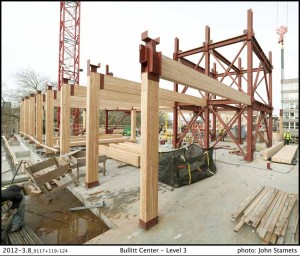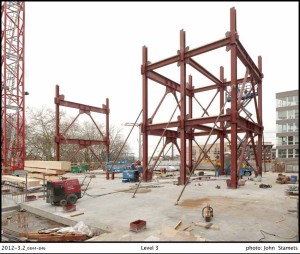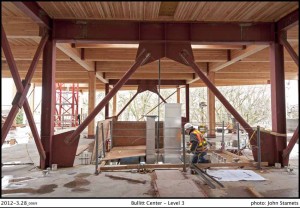Steel in the Bullitt Center
It takes a remarkably coordinated effort to ensure that the steel fabricated for the Bullitt Center is properly designed, detailed, and fabricated, to achieve tolerances of an eighth of an inch over a long span. The Bullitt Center emerges from the ground on a concrete base to level 3, where structural bones change to steel and timber. At the building’s core, a set of structural steel moment frames resists (lateral) wind and earthquake forces while the (vertical) floor loads are carried by a system of glulam timber columns and beams. The timber columns are set into precision fabricated steel buckets; steel helmets fitted onto the top of each column then receive the glulam timber beams. The glulam beams have been cut to an exact length at the mill with a precision end trim (PET). The glulam beams resting in the helmets have been cut to such a precise length that they fit into this span with only 1/8 inch of tolerance at each end.
The accuracy and tolerances demanded by the design of the Bullitt Center require a high level of teamwork and coordination. The sequence involves many team members checking the drawings at each step of development. Schuchart Construction receives construction documents from the Structural Engineer, DCI Structural Engineers, and delivers them to the subcontractor, Stearn’s Design Build of Lake Oswego, Oregon. The subcontractor then does detailed shop drawings of all the fabricated parts. These drawings are returned to be reviewed by the architect, the structural engineer, and the general contractor. The drawings are then sent back to the subcontractor with comments and corrections. Another version is resubmitted for review by the team. Once the updated documents are approved a set of “approved for construction” drawings are sent by the subcontractor to the steel fabricator. In this case the steel fabricator is making both the structural framing as well as the steel connector elements for the glulams. The steel members are fabricated in Deer Park, located in Eastern Washington.
Steel is a natural choice for a sustainably designed building. Steel is durable and has the highest strength to weight ratio of any building material. Structural steel is composed of approximately 95% recycled material, with 65% of that post-consumer material. Recycled material is called post-consumer when it is a waste material from households or commercial/industrial manufacturing waste. Recycled content is defined as pre-consumer if it consists of manufacturing waste. In the Bullitt Center project the steel used has as much as 83% post-consumer recycled content and 13% pre-consumer recycled content. With the use of scrap steel, the new product only requires 1% of virgin material. The scrap used can be from earlier jobs at the plant or purchased from other factories and scrap yards. Another benefit of using steel construction is that there is little on-site waste. The steel elements are fabricated in a shop and all the scrap created is recycled at the source. The rebar used for the construction of the Bullitt Center comes from a source in Portland, Oregon, made from 95% post-consumer recycled steel.
The steel industry has a tradition of recycled content. According to the Steel Recycling Institute, steel is North America’s most recycled material, with 65 million tons recycled each year. More steel, by weight, is recycled per year than paper, glass, and plastic combined. By recycling one ton of steel, 2500 pounds of iron ore, 1400 pounds of coal and 120 pounds of limestone are conserved (The Steel Recycling Institute). Since 1990 the steel industry has been able to reduce the energy intensity per ton of steel produced by 27% and CO2 emissions by 33%, according to the American Iron and Steel Institute. Steel recycling rates have increased from 65% in 1988 to 88% in 2010 (Steel Recycling Institute). Another remarkable feature of steel is that it can be recycled again and again. Steel, because of its performance, the high percentage of recycled content, and the fact that all the steel can be used again in the future, makes it a natural choice as a building material for the Bullitt Center.




